How to Profit From the 2010 Road Map to Economic Recovery
Stock-Markets / Investing 2010 Jan 11, 2010 - 05:17 AM GMTBy: Money_Morning
 Jon D. Markman writes: Getting both sides of a bear market and recovery right is the biggest test that investors face because it requires doing an about-face on a winning strategy.
Jon D. Markman writes: Getting both sides of a bear market and recovery right is the biggest test that investors face because it requires doing an about-face on a winning strategy.
The ideal investor would have sold in October 2007 when stocks were making new all-time highs, then stayed out of all subsequent rallies during the worst bear market in seven decades, and then bought back into the market at its once-unimaginable low after not just the wheels of the economy had fallen off, but seemingly the engine, doors and steering wheel as well.
Also, the ideal investor didn't just need to recognize those inflection points, but make the most of his observation by exiting in full in October 2007 and re-entering with guns blazing in March 2009. That is even harder. The most common scenario would be to exit partially and enter partially.
Recognizing that only the most prescient investors will get these inflection points exactly right, I have focused my long-term research since the 2000 bear market on paying as much attention as possible to the message of the ticker tape rather than economics or fundamentals when it comes to these calls.
That makes sense right?
The fundamentals were fantastic at the top and the economics were horrible at the bottom. No help. And even three to six months later the same was still true, especially for the bottom, when the economics stayed lousy well into the third quarter of the year and many observers say they arestilltoo crummy to justify equity investments.
The way that we leveraged the tape in both cases was very simple, but came out of a lot of testing. The mantra: Just follow the 10-month average of the Standard & Poor's 500 Index. It was the road map for the 2000-2003 bear market and recovery, and I believed it would provide the same guidance in 2007-2009, and it did. Sorry to sound like a broken record, but you have to stick with what works.
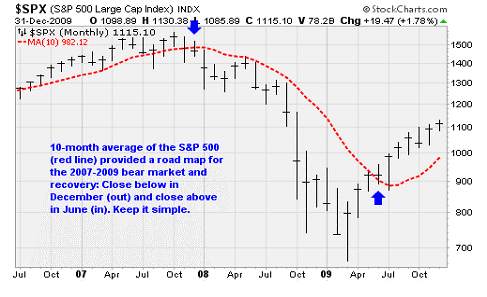
So what is the message of the tape now? Still positive; no change.
Yes, same as July, when the economy looked shaky but the tape was positive. Same as August, when people were claiming that "cash-for-clunkers" was a joke. Same as September, when people were fretting over the worst month of the year. Same as October, when people feared stocks had gone up too much too fast. Same as November, when people were complaining about the decline of the dollar. And same as December, when people were complaining the market was leveling off but the tape was positive.
Do you even remember all the side shows that got investors side-tracked last year? It would be fun to put together a list. A partial one would include the avian flu in Mexico that was declared a pandemic in mid-April. That shot down stocks for awhile The iShares MSCI Mexico Index Fund (NYSE: EWW) has gone up 55% since. Then there was the North Korean missile tests that shot down South Korean stocks in May. The iShares MSCISouth Korea Index Fund(NYSE: EWY) stocks is up about 40% since then. And Brazilian stocks collapsed on word of a new ADR tax, but our Market Vectors Brazil Small-Cap ETF (NYSE: BRF) is up 20% since.
The point is that there are always a lot of reasons to worry about the global economy, but if the tape is positive investors quickly discount the issues and move along.
If you would like to know in advance some of the concerns that investors will have this year, here is my quick nine-point checklist of things to worry about:
- Some flavor ofhealthcare reform will become law by February.
- Congress will lightlyreform the U.S. financial system, probably for the worse, and possibly including curbs on the U.S. Federal Reserve.
- Democrats will probably lose at least 25 seats in the House and 5 seats in the Senate as a jobless recovery, distress over deficits and healthcare, and anger over a prolonged war in Afghanistan rattle voters' confidence.
- China business will come to be seen increasingly like the U.S. subprime market on steroids, with banking losses increasingly hard to hide.
- Efforts to battle global climate change will stallas cap-and-trade bills die in Congress and even Europe loses heart for the cost of the fight, especially as temperatures cool.
- The U.S. economy will grow faster than the consensus expects, prompting newdemands among bond vigilantes for the Federal Reserve to raise interest ratesbefore enough jobs have been created to ensure that the recovery has a fighting chance at lasting a year.
- Iran could metastasize from nuisance to genuine nuclear threat, prompting Israel with U.S. help to take action. Or its nascent revolution could grow to endanger the theocratic government sufficiently enough to prompt even more brutal reprisals, forcing U.S. and European governments to take sides.
- The emergent al-Qaida threat in Yemen -which is bordered by Saudi Arabia and Somalia - could force the United States to open a third front in what used to be called the global war on terror.
- An unlocked Google Inc. (Nasdaq: GOOG) wireless phone service, due to debut this week, blows up the telecom industry's business model without adding significant new revenue to Google itself, yielding many losers and no winners.
The fascinating thing is that all of these problems could blow up on the same Tuesday in April, and if investors are still in the mood to buy stocks because interest rates are low, earnings are growing ahead of expectations, legislated fiscal stimulus is still pouring taxpayer money into the economy, and government bonds are putting up no competition, then the market won't be derailed much.
My expectation is that there will almost certainly be a 10%-12% over as long as eight to 10 months in 2010, but by November the cyclical uptrend will regain traction and indexes will end the year with a gain.
If you would like me to nominate one item on my checklist of concerns as the one that might present the most serious threat to world trade, I would put the Iran mess at the top of the list. Any threat to the disruption of energy supplies would send oil and gas prices soaring, so as a precaution we likely to add exposure to oil and gas futures and producers to our recommendation list ahead of time. Stay tuned.
Back to the 1950s?
Now here's some perspective on the decade past, which some observers have decided to dub the "naughts" since it was a bit of a disappointment. Currently, there are about 131 million Americans working -- a level that was first reached in February 2000. The Federal Reserve's index of U.S. industrial production stood at 98.6 in October, back to the level of May 1999. And operating earnings per share of S&P 500 companies averaged roughly $59 at an annual rate over the last two quarters. This is nearly the same level that prevailed in Q2 and Q3 of 2000.
By many other metrics, the U.S. economy has actually lost ground over the last ten years. Household net worth has plummeted as homes prices have been slashed while stock prices, represented by the Dow Jones Industrial Average, remain 26% off their peak. Debt levels climbed to a peak in 2007 -- with debt at 133% of disposable income -- and remains painfully high.
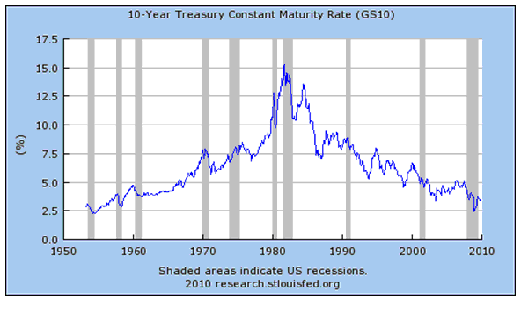
Such dismal performances have pushed long-term interest rates down to levels not seen in 50 years (see chart above). As observed last week, I see lots of similarities between our current era and that of the 1930s, the 1940s, and the 1950s. We've had a credit fueled asset bubble and major economic shock that turned excessive optimism into suffocating pessimism. Our capital misallocation funded overinvestment in housing; theirs fueled misallocation to stocks.
We've seen government finances deteriorate, but for different reasons. In the 1940s, the U.S. Treasury issued debt to defeat the Empire of Japan and the Third Reich. In the 2000s, we issued debt to defeat terrorists, liberate Iraq and Afghanistan from oppressive regimes, and save Wall Street bankers from their own excesses.
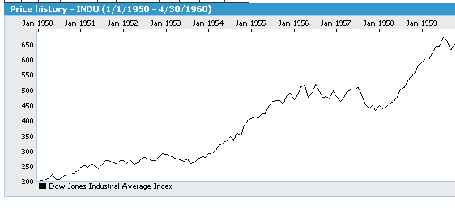
If the analog holds true, than the 2010s could be a modest repeat of the 1950s. It was during this time that middle class was rebuilt from the ashes of the Great Depression and sadness over the terrible loss of life in both World War II and the Korean War. America's technological and industrial prowess pushed it forward. The Dow Industrial Average more than tripled from 200 to 650. Houses were built. Wages grew. Jobs were created. Government debt was repaid.
It was not an easy ride. The economy suffered from four separate recessions during the 12 years between 1949 and 1961. Historian Robert Sobel wrote in hisThe Big Board: A History of the New York Stock Market that "the bull market of the fifties was born in the midst of bad business news." President Eisenhower put off tax cuts to balance the budget while the Federal Reserve tightened policy to fight inflation.
Yet as the stock market crossed its 1929 high in December 1954, investors who were heavily invested in bonds were forced to buy stocks at ever dearer prices. The trend reached a climax in 1958 as the Treasury tried to sell a large number of long-term bonds to lock in low interest rates (current Treasury Secretary Tim Geithner has indicated he would like to do this). In Sobel's words the "bond market was swamped, and had its most abrupt collapse on record." Despite concerns over high price-to-earnings ratios and low dividend yields, stocks continued to climb as capital took flight from a tumbling bond market. It was a flightfromsafety.
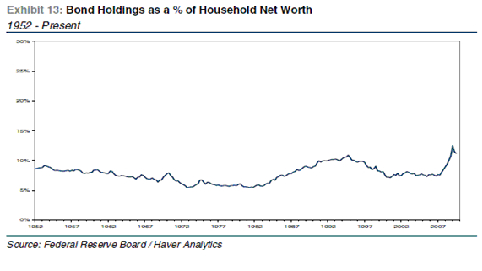
I believe this slice of history has a shot at repeating. No one has invested in an environment of steadily rising U.S. long-term interest rates from such low levels in more than fifty years. Institutional investors, pension funds, foreign governments, and the average investors will soon relive the predicament in which their parents or grandparents were forced to navigate. Just check the chart above to see how bond holdings among households recently reached new heights. The last major peak came in 1995, just before a massive upswing in the stock market.
In the face of rising interest rates, rising inflation, increased economic profits, and an expansion in economic activity, the rational decision has always been to buy stocks. Rising long-term interest rates and falling bond prices can happen even if the Fed, as we expect, keeps short-term interest rates on hold throughout 2010. (The Fed may do this for two reasons besides the obvious desire to help businesses and consumers in a nascent recovery: It will likely try to keep the interest rate the United States pays on its debt spending as low as possible, so as not to make the deficit any worse than it is; and as a payback by Ben Bernanke to President Obama for retaining him as central bank chief.)
So this is one of our big ideas moving forward. We will continue to explore the 1950s/Bond Market Selloff idea over the coming weeks as we prepare to profit from these trends.
If there is one reason to imagine that this won't come to pass it's the potential of the U.S. dollar to continue its advance, trimming the chances of U.S. multinationals to sell in foreign markets.

As you can see in the chart above, the dollar is in the process of making a continuation pattern that technicians call aflag. Technicians measure the potential size of the next move by subtracting the base of the flagpole (1) from the top of the flagpole (2) and adding that number to the breakout (4). That would be roughly three index points, which would be a gigantic move for the currency, and likely have many important ramifications, such as a setback in international stocks and commodities, much as we saw in early December. I'm going to watch this very carefully, because a breakout over the pennant would impel us to hasten our recent exit from non-U.S. stock exchange-traded funds (ETFs).
Homes and Banks
The best industries during the past week were residential construction companies and regional banks, which were of course among the worst performers last year. The new decade is starting off with a classic last-shall-be-first posture, as investors turn their attention from high-valuation groups to low-valuation groups. Beaten and bruised little banks were up all across the field on Wednesday, as investors started to sniff out the potential for a serious run higher in these companies that can be bought simply on the basis of cheapness, no matter what you think of their fundamental prospects.You have to understand that banks and financial services companies plummeted so much during the 2007-2009 collapse that the 143% advance made by the big-caps in the group last year still left them 60% below their February 2007 highs. How inexpensive are they? The median bank trades for just 1.1 times book value, vs. 2.2x for the broad market. That means the average financial institution could double just to get to the average value of all their peers. Normally you would be happy to find a group that is just 50% cheaper than the market.
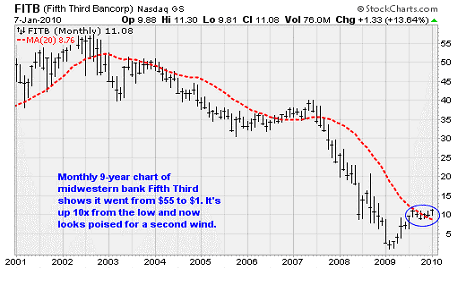
As you can see above, surviving super-regionals likeFifth Third Bancorp(Nasdaq: FITB) have leveled off in the past six months after massive initial recoveries from the 2008 credit disaster, and now look poised for a new leg higher. This would really shock most investors, who consider the regional banks largely bankrupt due to large portfolios of non-performing loans. It is something that can happen because most people believe that it can't happen.
The scenario reminds me of a conversation that I had in March last year with the pioneering technical analyst Tom Demark, who has made a career out of advising the likes of billionaire investor Steve Cohen about extreme oversold and overbought conditions. We were discussing the nature of bottoms of sectors and markets, and I asked whether they were created when savvy investors are in there buying, and overwhelm the bears, or is it something else?
DeMark said: "People think that at bottoms, smart people are in there buying. Not true. Markets make a bottom not because of smart buyers but because the last dumb seller has sold. Logically markets make lows in skepticism, and that usually includes the so-called smart money."
The point is that regional banks are probably sold out, which gives them an opportunity to advance. DeMark added that following there's usually a three to four day rally off the low before there's at least a modest test of meaningful market and sector bottoms; then the up move should continue.
Bank On It
What was behind the financials' rally? Key was an upgrade on Wednesday ofBank of America Corp.(NYSE: BAC) by Credit Suisse Group AG (NYSE ADR: CS) analysts. It came as part of a slug of new research from the Credit Suisse team on the group. I snagged copies of the reports for you. Here are the highlights:First, the analyst team noted that Bank of America is the "cheapest of our large cap banks" and is trading at 6.1 times normalized earnings versus the 7.6 times that its peer group trades at. Moreover, the Credit Suisse team noted that the recent full repayment of the government's $45 billion in bailout funding "relieves a significant overhang on the shares" and has positive near-term financial implications by contributing to both earnings per share and book value. The earnings boost results from the elimination of the $3.6 billion in annual interest owed to the government's preferred share stake.
Second, the Credit Suisse analysts continue to be skeptical on the bank industry overall. We agree, which is why we've decided to focus on the investment banks and brokerages in the sector via the SPDR Capital Markets fund. Although the commercial banks are not expensive by historical standards, the analysts warned of high credit costs, looming regulatory reform, lackluster balance sheet growth, and declining mortgage revenues.
And finally, the Credit Suisse team was much more optimistic on the universe of brokerages, advisory firms, securities traders, and financial exchanges. They see increased revenue and earnings growth thanks to stock market strength, fund inflows, bond underwriting and lower market volatility. Overall, the sector group appears to be 20% undervalued against historical averages with the largest disparity among the investments banks (a 40% discount).
Week in Review
Monday:The ISM Manufacturing Index moved further into expansion territory in December: The index increased to 55.9, beating the consensus estimate of 54.8 and the prior month's 53.6. Any reading over 50 indicates the manufacturing sector is expanding. The increase in new orders was the big surprise, jumping more than 5 points to 65.5 -- indicating continued gains in the months ahead.Tuesday:A batch of mixed data. Pending home sales dropped 16% in November month-over-month as the now-extended first-time home buyer tax credit expired. This ended nine consecutive months of gains and was much worse than the 3% decline that was expected. The National Association of Realtors, which is known to be a pretty optimistic bunch, said lower prices and expanded stimulus measures should result in a springtime rebound for housing.
On the positive front, retail sales last week improved to level not seen since the middle of 2008 while a big jump was seen in November factory orders. Also, domestic motor vehicle sales for December came in at a better-than-expected annualized rate of 8.5 million units. Overall, the data indicates that a strong recovery continues in manufacturing, which is at the heart of the economy. This is a really big deal.
Wednesday:The ISM Non-Manufacturing Index, which surveys firms in sectors like agriculture, services, and transportation, moved back into expansionary territory in December with a reading of 50.1. This was slightly below the consensus estimate of 50.4 but above November's 48.7 result. New orders increased to 52.1.
Thursday:Retailers reported strong December sales, up 2.9% overall compared to the same period in 2008. Total holiday sales increased 1.8%.Macy's Inc.(NYSE: M) Chief Executive Officer Terry Lundgren said there was "more stability and more visibility" as consumer confidence returns.
Friday:December payrolls come in below expectations with a loss of 85,000 compared to the expected gain of 10,000. Unemployment rate remains at 10%.
The Week Ahead
Monday:A series of U.S. Treasury auctions could put pressure on bond prices.
Tuesday:The latest International Trade report published by the U.S.Bureau of Economic Analysis, a division of the Commerce Department,will provide an update on the balance of the nation's imports and exports. A better trade balance strengthens gross domestic product (GDP).
Wednesday:The Federal Reserve releases its latest Beige Book report of economic conditions.
Thursday:The government reports December retail sales. Expect a strong report after retails reported healthy results and the already released motor vehicle sales report showed a 2.9% increase for the month.
Friday:A busy day with updates on inflation, industrial production, and consumer sentiment.
[Editor's Note: With the U.S. economy picking up steam, there has seldom been a better time to invest. Valuations are low and the potential for profit is extraordinarily high. But picking the right investments is key - and having a guide is crucial. Jon D. Markman should be that guide. Markman, a veteran portfolio manager, commentator and author, is offering investors a unique opportunity to capitalize on the current bull market by subscribing to his Strategic Advantage newsletter. For more articles like the one you just read, or for more information about Markman's Strategic Advantage service, please click here.]
Source: http://moneymorning.com/2010/01/11/road-map-to-recovery/
Money Morning/The Money Map Report
©2010 Monument Street Publishing. All Rights Reserved. Protected by copyright laws of the United States and international treaties. Any reproduction, copying, or redistribution (electronic or otherwise, including on the world wide web), of content from this website, in whole or in part, is strictly prohibited without the express written permission of Monument Street Publishing. 105 West Monument Street, Baltimore MD 21201, Email: customerservice@moneymorning.com
Disclaimer: Nothing published by Money Morning should be considered personalized investment advice. Although our employees may answer your general customer service questions, they are not licensed under securities laws to address your particular investment situation. No communication by our employees to you should be deemed as personalized investment advice. We expressly forbid our writers from having a financial interest in any security recommended to our readers. All of our employees and agents must wait 24 hours after on-line publication, or 72 hours after the mailing of printed-only publication prior to following an initial recommendation. Any investments recommended by Money Morning should be made only after consulting with your investment advisor and only after reviewing the prospectus or financial statements of the company.
Money Morning Archive |
© 2005-2022 http://www.MarketOracle.co.uk - The Market Oracle is a FREE Daily Financial Markets Analysis & Forecasting online publication.



